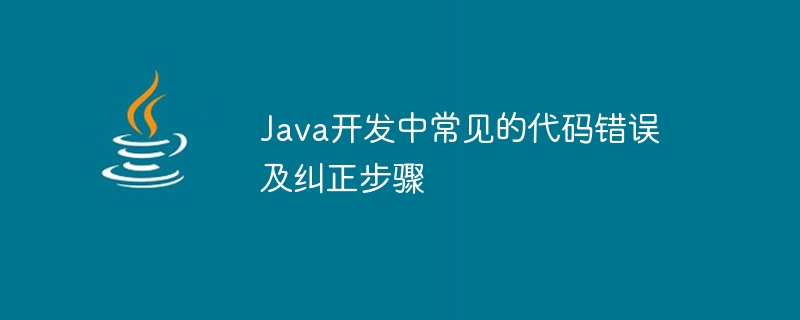Home >Java >javaTutorial >Common code errors and correction steps in Java development
Common code errors and correction steps in Java development
- PHPzOriginal
- 2023-10-09 20:37:54900browse

Common code errors and corrective steps in Java development
As one of the widely used programming languages, various code errors often occur in Java during the development process. These errors not only cause the program to fail, but may also make the code difficult to maintain and extend. For these common errors, this article will introduce their causes and corresponding corrective steps, and provide specific code examples.
1. NullPointerException
Null pointer exception is one of the most common errors in Java development. It usually occurs when using a reference variable that does not point to any object, that is, it is null.
Error example:
String myString = null; System.out.println(myString.length());
Correction steps:
- Before using a reference variable, first determine whether the variable is null, you can use if statement or ternary operation symbols to complete.
if (myString != null) {
System.out.println(myString.length());
}- When defining a reference variable, initialize its value to ensure it is not empty.
String myString = ""; System.out.println(myString.length());
2. ArrayIndexOutOfBoundsException)
The array out-of-bounds exception occurs when accessing an array, and the subscript exceeds the valid range of the array.
Error example:
int[] myArray = new int[5]; System.out.println(myArray[5]);
Correction steps:
- Before using array elements, first determine the relationship between the length of the array and the index to ensure that it does not exceed the range of the array.
if (index >= 0 && index < myArray.length) {
System.out.println(myArray[index]);
}- When creating an array, make sure the allocated length matches the requirements.
int[] myArray = new int[6]; System.out.println(myArray[5]);
3. Type conversion exception (ClassCastException)
Type conversion exception usually occurs when an object is forced to be converted to a type that is incompatible with its type.
Error example:
Object myObject = "Hello"; Integer myInteger = (Integer) myObject;
Correction steps:
- Use the instanceof keyword for type checking before performing cast type conversion.
if (myObject instanceof Integer) {
Integer myInteger = (Integer) myObject;
}- Ensure that when performing type conversion, there is an inheritance or implementation relationship between the two types.
Object myObject = 5; Integer myInteger = (Integer) myObject;
4. Logical errors
Logical errors are errors that occur when writing code, causing the program to behave inconsistently with expectations.
Error example:
int x = 5;
int y = 10;
int max = Math.max(y, x);
if (max == x) {
System.out.println("x is the maximum");
} else if (max == y) {
System.out.println("y is the maximum");
}Correction steps:
- Check whether the logical expression is correct and ensure that the program takes the correct branch as expected.
int x = 5;
int y = 10;
int max = Math.max(y, x);
if (max == x && max != y) {
System.out.println("x is the maximum");
} else if (max == y && max != x) {
System.out.println("y is the maximum");
} else {
System.out.println("x and y are equal");
}- Use debugging tools to track the execution process of the code and discover the cause of logical errors.
Summary:
This article introduces common code errors in Java development, including null pointer exceptions, array out-of-bounds exceptions, type conversion exceptions and logic errors, and gives the corresponding Corrective steps and specific code examples. By understanding these common errors, we can better master Java programming technology and improve the quality and reliability of our code.
The above is the detailed content of Common code errors and correction steps in Java development. For more information, please follow other related articles on the PHP Chinese website!

